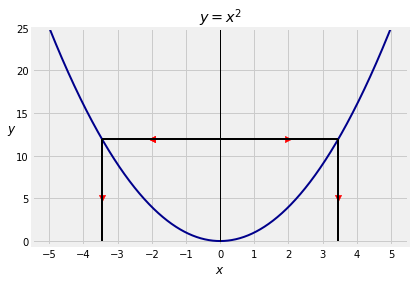Two-to-One Functions
Contents
16.4. Two-to-One Functions#
Let \(X\) have density \(f_X\). As you have seen, the random variable \(Y = X^2\) comes up frequently in calculations. Thus far, all we have needed is \(E(Y)\) which can be found by the formula for the expectation of a non-linear function of \(X\). To find the density of \(Y\), we can’t directly use the change of variable formula of the previous section because the function \(g(x) = x^2\) is not monotone. It is two-to-one because both \(\sqrt{x}\) and \(-\sqrt{x}\) have the same square.
In this section we will find the density of \(Y\) by developing a modification of the change of variable formula for the density of a monotone function of \(X\). The modification extends in a straightforward manner to other two-to-one functions and also to many-to-one functions.
16.4.1. Density of \(Y = X^2\)#
If \(X\) can take both positive and negative values, we have to account for the fact that there can be two mutually exclusive ways in which the event \(\{ Y \in dy \}\) can happen: either \(X\) has to be near the positive square root of \(y\) or near the negative square root of \(y\).

So the density of \(Y\) at \(y\) has two components, as follows. For \(y > 0\),
where
and
We have used \(g'(x) = 2x\) when \(g(x) = x^2\).
For a more formal approach, start with the cdf of \(Y\):
Differentiate both sides to get our formula for \(f_Y(y)\); keep an eye on the two minus signs in the second term and make sure you combine them correctly.
This approach can be extended to any many-to-one function \(g\). For every \(y\), there will be one component for each value of \(x\) such that \(g(x) = y\).
Quick Check
\(U\) is uniform on \((0, 1)\). To find the density of \(V = U^2\), do you have to take into account the fact that the square is a two-to-one function? Either way, find the density of \(V\), and check that your answer integrates to 1.
Answer
No, the square is one-to-one on \((0, 1)\). For \(v \in (0, 1)\), \(f_V(v) = 1/2\sqrt{v}\).
Quick Check
\(R\) is uniform on \((-1, 1)\). To find the density of \(S = R^2\), do you have to take into account the fact that the square is a two-to-one function? Either way, write the density of \(R\), find the density of \(S\), and check that your answers integrate to 1.
Answer
\(f_R(r) = \frac{1}{2}\) for \(r \in (-1, 1)\). Yes, the square is two-to-one on \((-1, 1)\). For \(s \in (0, 1)\), \(f_S(s) = 1/2\sqrt{s}\).
16.4.2. Square of the Standard Normal#
Let \(Z\) be standard normal and let \(W = Z^2\). The possible values of \(W\) are non-negative. For a possible value \(w \ge 0\), the formula we have derived says that the density of \(W\) is given by:
By algebra, the density can be written in an equivalent form that we will use more frequently.
This is a member of the family of gamma densities that we will study later in the course. In statistics, it is called the chi squared density with one degree of freedom.


